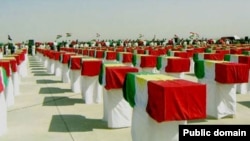Thirty years ago today, then-Iraqi President Saddam Hussein started Operation Anfal, his murderous campaign against the populations in northern Iraq. The al-Anfal campaign began in 1986 and ended in 1989.
In 1987, toward the end of the war between Iran and Iraq, Saddam Hussein put his cousin, Ali Hassan al-Majid, who was infamous for his brutality, in charge of Iraq’s Northern Region, which included Iraqi Kurdistan.
What followed was a horrifying display of killing and destruction. The al-Anfal campaign was meant to punish and exterminate the Kurdish population, and to terrorize other minority ethnic groups, including Christians, Shabaks, Iraqi Turkmen, Yazidis, and Mandeans.
Civilian communities were bombarded by aircraft and artillery and attacked by heavily armed infantry. Civilians were rounded up, boys and men of fighting age were summarily executed or later executed en masse. The rest were confined to concentration camps where some died of starvation or exposure. Some 4,000 Kurdish villages and at least 31 Assyrian communities were razed to the ground during the al-Anfal Campaign.
Yet the most heinous atrocity committed by the Iraqi government against its own people was the murder by poison gas of thousands of civilians in as many as 24 villages. For this deed, al-Majid earned the nick-name Chemical Ali.
In all, the al-Anfal campaign killed anywhere from 50,000 to 100,000 non-combatant civilians and displaced at least one million of Iraq’s 3.5 million Kurds.
In recognition of the loss of so many innocent civilians during the al-Anfal campaign of 30 years ago, all Iraqis should unite to honor the memory of those lost by working together to find a joint path forward in rebuilding Iraq.












